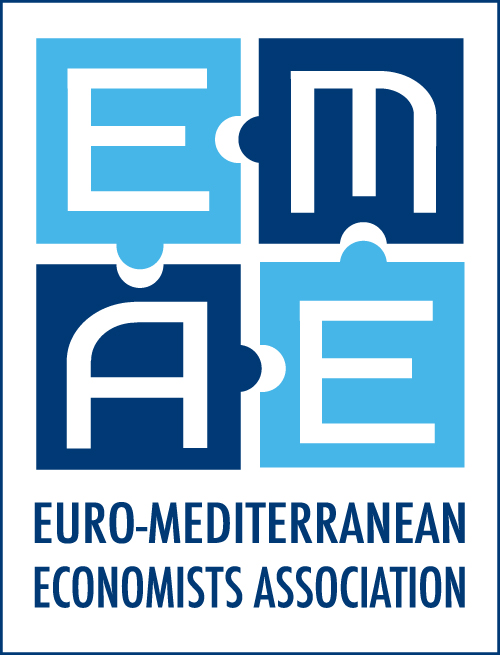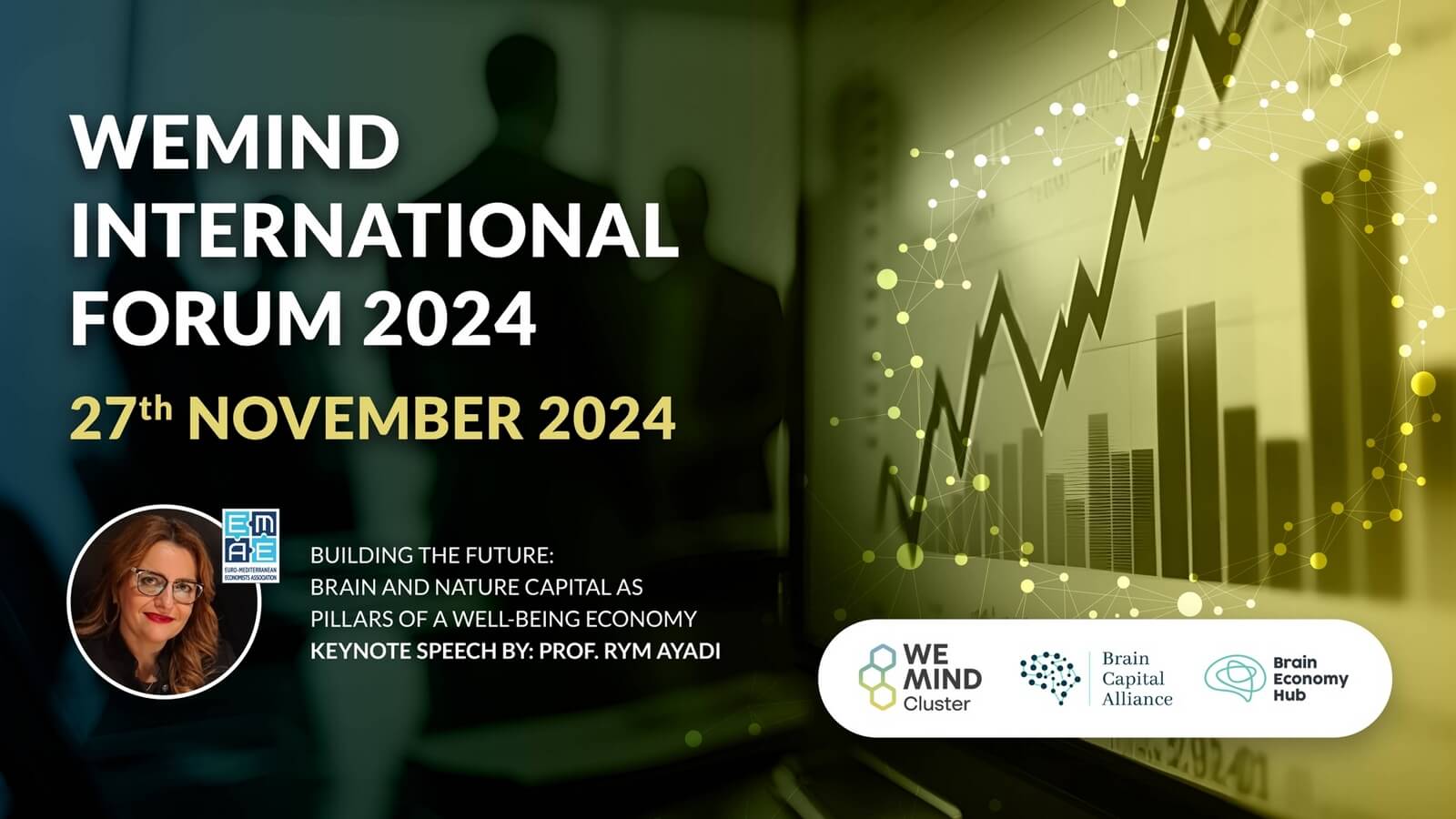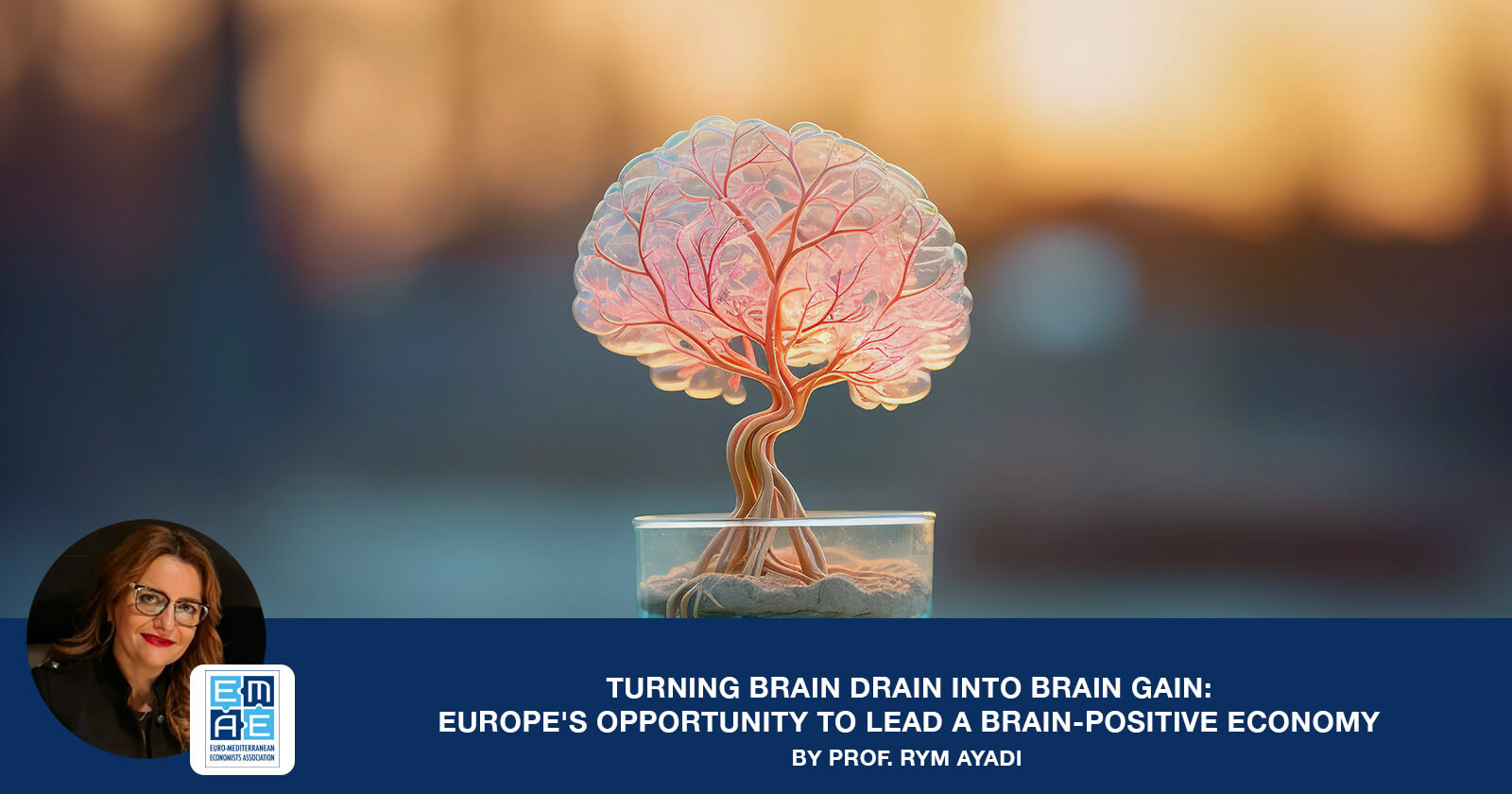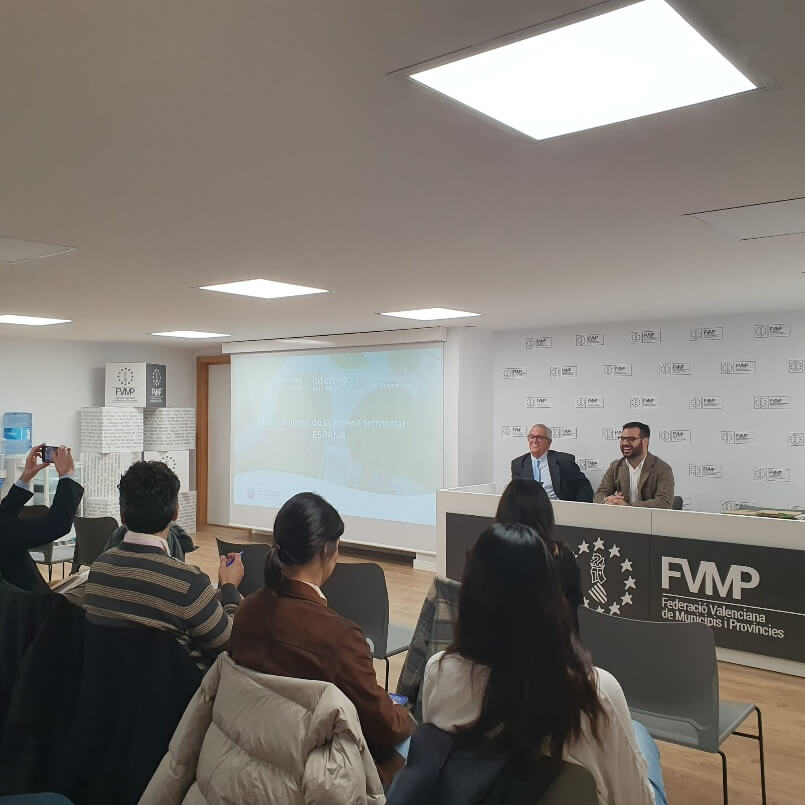By Prof. Rym Ayadi, Founder and President of Euro-Mediterranean Economists Association (EMEA)
As we face crises of mental health, environmental degradation, and economic inequality, we must urgently transition from extractive systems to regenerative ones.
A transformative vision is needed: a well-being economy where Brain and Nature Capital form the foundation for resilience, equity, sustainability and regeneration.
This means reimagining economies not as mechanisms for short-term growth but as ecosystems that enhance the well-being of people and planet alike.
The Need for a Regenerative Well-being Economy
The limitations of traditional economic models are increasingly evident.
GDP has grown globally by an average of 3% annually over the past decade, but this growth has been accompanied by alarming 3 trends:
- Mental health disorders now affect over 970 million people worldwide according to WHO in 2019. After covid 19 pandemic anxiety and depression has increased according to WHO
- Humanity is using resources at 1.7 times the Earth’s capacity, leading to a global overshoot that depletes ecosystems faster than they can regenerate according Global Footprint Network.
- Income inequality has widened with the richest 10% owning 76% of global wealth according to credit Suisse 2023 wealth report.
The well-being economy is an economic framework that prioritizes the health, happiness, sustainability and resilience of people and the planet BEYOND mere financial returns and growth.
This vision is deeply rooted in regenerative principles, which go beyond sustainability to actively restore and enhance the systems on which we depend—both human and ecological. We must go back to the symbiotic relationship between nature and health, and in particular brain health.
A regenerative well-being economy embraces three principles that prioritize the flourishing of natural and human systems:
- Restoration: Actively repairing ecosystems and social systems.
- Resilience: Building systems that can adapt and thrive in the face of crises.
- Circularity: Designing out waste and keeping materials in use.
All three principles underpinned in science and innovation.
This framework aligns deeply with Nature Capital and Brain Capital , both of which are essential to regenerating societal and ecological health.
Nature Capital: Regenerating the Planet’s Life Support Systems
Nature Capital encompasses the ecosystems and biodiversity that sustain all life.
A regenerative economy seeks not only to stop environmental damage but to restore ecosystems to a thriving state through innovation.
The stakes are high:
- Biodiversity has declined by nearly 70% since 1970 according to WWF Living Planet Report.
- Ecosystem services, which are worth an estimated $125 trillion annually, are under severe threat according to UN Environmental Programme.
Regenerative principles guide us towards restoring and valuing Nature Capital through:
- Nature-Based Solutions: Projects like reforestation, wetland restoration, and regenerative agriculture can sequester carbon, enhance biodiversity, and improve local economies. For every $1 invested in these solutions, $9 in economic benefits are generated according to the World Resources Institute.
- Circular Economies: Transitioning to systems where waste is minimized, and materials are reused. The Ellen MacArthur Foundation estimates that circular economy practices could reduce global carbon emissions by 45% by 2050.
- Living Economies: Adopting frameworks such as the Gross Ecosystem Product (GEP), which measures the value of ecosystems to human well-being, alongside GDP.
Brain Capital: Regenerating Human Potential
Brain Capital refers to the cognitive, emotional, and social capacities of individuals.
In regenerative economies, the health and potential of people are seen as assets to cultivate and enhance, not exhaust or exploit.
Consider these challenges:
- Mental health conditions are expected to cost the global economy $6 trillion annually by 2030 according to World Economic Forum.
- Only 2% of global health budgets are allocated to mental health, despite its outsized impact on economic and social well-being according Lancet Commission.
The brain capital, which is encompassing brain health and brain skills is driven by several determinants on which we can act to improve our brain health as a society
In a regenerative framework, investment in Brain Capital prioritizes:
- Mental Health Equity: Expanding access to mental health services, especially in underserved communities, to ensure everyone can contribute their full potential.
- Lifelong Learning Ecosystems: Transitioning from extractive education models – tailored to labor market specific needs to dynamic, inclusive systems that support continual skill development and adaptability and healthy habits (as simple as adherence to movement).
- Workplace Resilience: Redesigning work environments to promote well-being, innovation, movement and emotional intelligence.
Evidence shows that these investments pay off. For every $1 invested in mental health, there is a $4 return in improved productivity and societal well-being according to the WHO.
The aging population, particularly in developed countries, presents both challenges and opportunities for Brain Capital, as older individuals represent a vast reservoir of experience, knowledge, and skills that can drive societal resilience and innovation.
However, with age comes an increased risk of cognitive decline and mental health challenges, including conditions like dementia, which currently affects over 55 million people worldwide and is projected to triple by 2050 according to the WHO.
Investing in Brain Capital for aging populations involves advancing neurotechnologies, promoting lifelong learning, and changing lifestyle (adherence to exercise, healthy nutrition and hydration, optimal sleep..) and creating inclusive environments that support mental and cognitive health.
Strategies such as workplace adaptations, community engagement programs, and brain health initiatives can not only mitigate age-related cognitive decline but also empower older adults to remain active contributors to the economy and society.
By prioritizing policies and investments that nurture Brain Capital across all ages, societies can harness the potential of their ageing populations while addressing the critical need for cognitive and emotional well-being.
Regenerative Synergies: Brain and Nature Capital Together
The intersection of Brain and Nature Capital creates co-benefits. It is where regenerative principles thrive:
- Cognitive Restoration through Nature: Studies show that time in green spaces reduces depression by 30% and enhances cognitive function according to the Lancet Planetary Health.
- Regenerative Communities: Urban design projects, such as “15-minute cities,” integrate nature into daily life, boosting mental health and reducing environmental footprints.
- Innovation Ecosystems: Regenerating Nature Capital fosters brain-driven innovations, such as biomimicry technologies inspired by natural processes.
When we align regenerative principles with these two capitals while recognizing the co-benefits, we create a virtuous cycle: healthy minds innovate sustainable solutions, while thriving ecosystems nurture mental and physical well-being.
Indicators for a Regenerative Economy
To build a wellbeing economy we must adopt measurable indicators that reflect progress of both brain capital and nature capital along with the regenerative principles. These are some indicators to reflect upon:
- Brain Capital Indicators:
◦ Mental Health-Adjusted Life Years (MHALYs) to track mental health and cognitive well-being.
◦ Education Adaptability Index to measure the alignment of education systems with future skills towards the economy we wish to achieve. - Nature Capital Indicators:
◦ Biodiversity health Index to evaluate ecosystem health.
◦ Natural Capital Accounts to integrate the value of ecosystem services into national accounts. - Regenerative Metrics:
◦ Gross Ecosystem Product (GEP): Measuring ecosystem contributions to economies.
◦ Circularity Metrics: Tracking resource efficiency and waste reduction.
To track and optimize the intersection of Brain and Nature Capital, innovative metrics are needed:
- Green Space Accessibility Index: Measures public access to natural environments and its impact on mental health outcomes.
- Mental Health-Adjusted Ecosystem Services Value: Quantifies the contribution of ecosystems to mental and emotional well-being.
- Nature-Based Education Metrics: Tracks the integration of nature into educational curricula and its effects on cognitive development.
These indicators will guide our transition toward economies that regenerate more than they extract.
The Euro-Mediterranean Economists Association developed open access global dashboards to monitor the key indicators per country.
The Global Brain Capital Dashboard1 is an analytical tool designed to quantify and monitor “Brain Capital,” encompassing the social, emotional, and cognitive resources of individuals within a society. Developed collaboratively with the OECD Neuroscience-inspired Policy Initiative, the Brain Capital Alliance, and the Euro-Mediterranean Economists Association, the dashboard aims to inspire innovative policy solutions by providing comprehensive insights into factors influencing brain health and skills. The dashboard is structured around three main pillars:
Brain Capital Drivers: This pillar examines factors that influence the accumulation of brain capital throughout an individual’s life. Key dimensions include: Pre-natal Factors: Conditions affecting brain development before birth. Food and Nutritional Security: Access to adequate nutrition essential for brain health. Health Services and Public Policies: Availability and quality of healthcare services and supportive policies. Natural Environment and Climate: Environmental conditions impacting brain health. Cultural Environment: Societal norms and values influencing cognitive and emotional development. Social Conditions: Factors like social connections and community support. Education: Access to quality education fostering cognitive skills. Digitalization: The role of digital technologies in cognitive development.
Brain Health: This pillar focuses on the mental and neurological well-being of the population, tracking: Absence of Disorders: Prevalence rates of conditions such as depression, anxiety, Alzheimer’s disease, stroke, and long COVID-19. Life Stage-Specific Issues: Challenges related to childhood, adolescence, and aging.
Brain Skills: This pillar assesses the cognitive and non-cognitive abilities vital for personal and societal development, including: Cognitive Skills: Abilities related to learning, memory, reasoning, and problem-solving. Non-Cognitive Skills: Traits such as emotional intelligence, creativity, mental resilience, and social skills.
By integrating these pillars, the Global Brain Capital Dashboard offers a holistic view of the factors contributing to brain capital, serving as a valuable resource for policymakers and stakeholders aiming to enhance societal well-being and economic resilience through targeted interventions.
The TRIS Dashboard2, is an interactive, open-access platform designed to monitor and assess socio-economic development across countries. It is structured around four key pillars:
Transparent Governance and Accountability: Evaluates the openness and responsibility of governmental institutions. 2. Responsible Living and Social Rights: Assesses societal well-being and the protection of social rights. 3. Inclusive and Productive Economies: Measures economic inclusivity and productivity. 4. Sustainable Energy and Environmental Strategies: Monitors the adoption of sustainable energy practices and environmental policies.
Within each pillar, the dashboard provides various dimensions and indicators, allowing users to visualize and analyze data through interactive maps and country-specific plots. This facilitates a comprehensive understanding of a nation’s progress over time.
By offering a transparent and accessible platform, the TRIS Dashboard aims to inform policymakers, researchers, and stakeholders, enabling them to make data-driven decisions that promote sustainable and inclusive development.
Call to Action
The future depends on how we respond to the challenges before us. A regenerative well-being economy is not just a vision—it is a necessity for survival.
We must commit to:
- Embedding regenerative principles in economic policies to enhance both Brain and Nature Capital and recognize their co-benefits.
- Mobilizing resources for large-scale restoration projects, from reforestation to education reskilling system reform towards the transformative regenerative wellbeing model.
- Adopting metrics that reflect the true value of well-being, resilience, and regeneration.
- Closing the inequality gap – by investing massively in mental health, education and new technologies to uplift marginalized communities
By doing so, we can transform our economies into ecosystems of care, innovation, and restoration.
Prof. Rym Ayadi, EMEA President, and co-founder of the Brain Capital Alliance, delivered the keynote speech “Building the future: Brain and Nature Capital as Pillars of a Well-being Economy” at the WeMind International Forum on 27 November 2024. The event took place at the World Trade Center, Barcelona, and it was organsied by the WeMind Cluster with the support of Diputació de Barcelona, ACCIO and Generalitat de Catalunya.
Furthermore, EMEA in collaboration with WeMind Cluster, the Brain Capital Alliance, the Brain Economy Hub and the South Harbour Research & Development, organised the panel Discussion: “Towards a Brain Economy in Spain”.
For more info: EMEA President Prof. Rym Ayadi delivers keynote speech at the WeMind International Forum and Chairs panel on Brain Economy in Spain
Link to the Global Brain Capital Dashboard
Link to the Systems Change Lab





